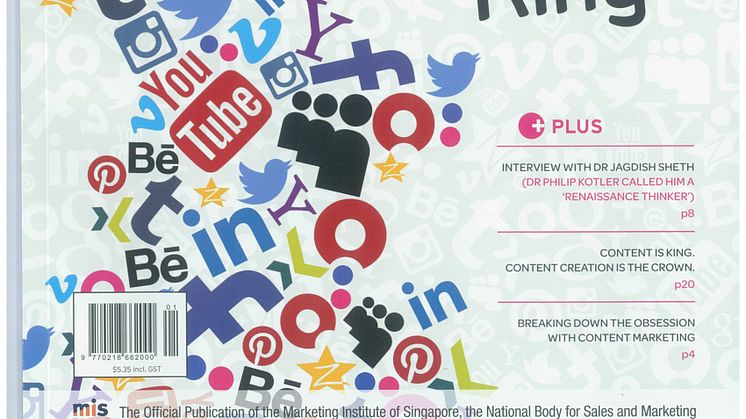
Blog post -
Troubleshooting your Content Marketing initiatives
Before you reallocate resources to traditional forms of advertising, here is a three point troubleshooting plan. You might be surprised that your content itself is not the problem.
Step 1: How are you measuring success?
Clearly, all marketing initiatives must help your sales force sell. But remember, content marketing is not advertising. It is not a short term sales tool. It is a lead generator that fosters a deeper relationship of trust with your target market, and results in sustainable customer relationships in the medium to long term.
Therefore, measuring content marketing by sales is not the right approach. I have made this point before at content marketing seminars I have spoken at, and come up against resistance. After all, the marketers gathered in the room are there to help their companies sell, especially at a time when they are under pressure to shorten sales cycles, and to sell more.
But think about the last time you gave a keynote address at a conference, or staged a seminar. How many people in the audience did you convert immediately after your presentation? You probably generated some leads, but sales – if any – are not likely to have flowed until weeks or months after the event.
The danger with treating content marketing as a sales tool is that it leads to blatant sales messages being included in the content …in which case, it loses its appeal as content. It becomes an advertorial, and all your effort to create compelling, valuable content is diluted. No one likes to be sold to.
So, what is a better way to measure the success of your content marketing initiatives?
The keyword is engagement: are your intended readers and viewers actually consuming your content? How many hits is your content getting across your blog, website or Facebook pages? How many times is your content being "liked"? Shared? Commented on?
What are the open rates of the emails you are sending out with your content? Most email engines will also tell you how many times the email was shared or forwarded, links clicked on, and images and graphics rendered.
In short, be sure you are measuring engagement, not sales.
Step 2: How are you distributing the content?
Measuring the success of your content marketing initiative by engagement automatically tells you whether you are actually reaching your target market.
If you are not getting an acceptable number of hits, shares, likes or opens, you are possibly not sending it to the right audience, or using the right channels, or even the right number of channels.
One mistake marketers make is not devoting enough budget to distributing content. They pour all their effort in resources into production, and not enough into getting the content seen. Ideally, you should spend 50% of your budget on distribution. That sounds high, but the alternative is to produce good content that nobody gets to see.
In general, you can't expect to create content, upload it to your blog or website, and expect your target audience to find it. You have to use multiple channels. Email blasts, a corporate blog, microsite, Facebook and Twitter are obvious channels.
Here are some additional pointers:
Your sales force. Your internal customers – your sales people – should be the first to distribute your content to their prospects. Sales people by definition have a big appetite for fresh talking points, to start or reinvigorate conversations with customers. That's especially the case if they have leads that are stuck.
The elephant in the room is that sales and marketing people often don't talk enough to each other, or don't get along. Sales thinks marketing isn't delivering enough leads; marketing thinks sales isn't following up fast enough to convert them.
Use content to break down this barrier. If your internal conversations improve, your external ones might, too.
LinkedIn. Share your content marketing pieces to your contacts and groups. Company pages allow you to share with all your followers, or an audience targeted by company size, industry, function, seniority, geography and language preferences.
But it shouldn't end there. You should also share your content with your personal network (if you feel uncomfortable to do so, read "Is your content compelling?" below).
And it doesn’t end there, either. Encourage all your staff to share the content through their personal networks, too. And not just your marketing colleagues, but everyone in the company, starting with your sales people.
If the content is good enough (see below), you might be positively surprised by how your staff respond.
Outbrain. Like Google AdWords, except instead of banner or text ads it places links to your content on the site of news organisations and others who have allocated space on their sites for this purpose. In my experience, Outbrain achieves excellent reach and satisfactory click-through rates.
Various content platforms. There are now many services available that package your content more meaningfully, such as Flipboard and Storify. I don't have sufficient space here to do justice to all of these, but you owe it to yourself and others producing the content that you consider all of these to take your content further. And that necessarily means your content should be mobile-ready, too.
Step 3: Is your content compelling?
Let's say you have changed the way you measure your content marketing success, and you have adjusted the way you are delivering the content. If you still have not found sufficient engagement with your target market it's time to ask yourself these questions about your content:
Does it deliver value? Good content must not just contain valuable information. It must be timely, meaning that it is written in a tone of urgency. Charts, graphics and images are just as important as the text, which is why video is so powerful.
Is the content balanced? Remove any and all sales pitches from your content. They only spoil the deep, trusting engagement you are aiming for. Balance means discussing all aspects of your subject matter candidly, including the negatives.
Who is the author of the content? This is a frequently overlooked, but important point. First, is the author identified as your company, or someone within your company? Ideally, you would but a name or face to the content you produce. Your audience will have an easier time relating to someone in the organisation. Second, what is the credibility of the source? An article written by your Head of Research & Development is more likely to be viewed as credible than an article attributed to your Head of Sales. There is a good reason why the words "author" and "authority" share the same root. Third, if your Head of R&D is not as good a presenter as your Head of Sales, train him/her up to be a better speaker.
Are you aggregating content? It is highly likely that other people in your industry also have meaningful, interesting views to share. Draw on their expertise, or even pull their YouTube videos into your playlist. Curating other people's content is as important as creating your own.
Is it fun? A lot of emphasis among Singapore markets is on value, and ensuring useful facts and substantiating data are presented. This is a good start. But to create the emotional connection to your audience that is essential to building a relationship, your content must also be entertaining.
If your content is lacking in any of the above points, it could be the reason it is not receiving the likes and shares you are hoping for, and possibly also explains why you or other members of your organisation are reluctant to share it with their own LinkedIn contacts.
Step 4: Have you given it enough time?
Content marketing is a medium to long term initiative in thought leadership. If you have the right content, distributed through the right channels, you might just need to give it a little time to yield results. Engagement does not happen overnight (or do you know anyone who got engaged to someone they only just met)?
But if you stay the course, your customer relationships will be deeper, more loyal and ultimately more profitable.
**This article first appeared in the Marketing Institute of Singapore's Singapore Marketer magazine and is reproduced by permission. Click on the Attached PDF document below to see how it appeared.
